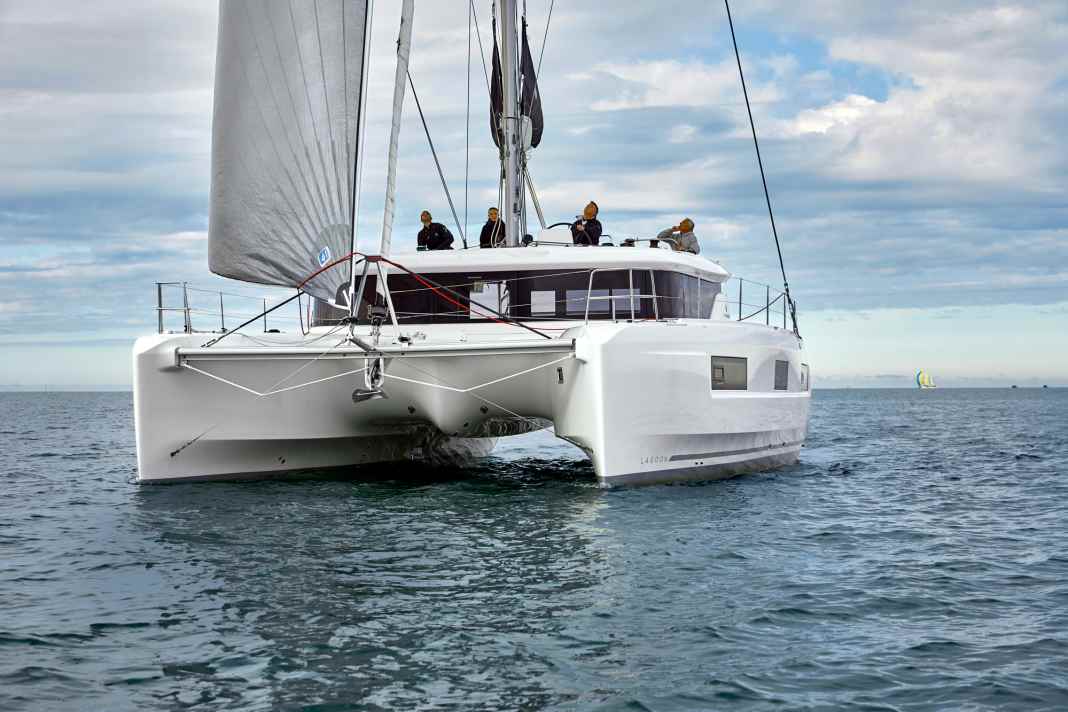





You get used to everything somehow and at some point - including high-sided catamarans with huge deckhouses and a flybridge on top. Furthermore, the old-school aesthetic sensibility, which still favours long, narrow and flat hulls as the pinnacle of development in yacht building, will no longer play a role for a potential cat buyer. Those who like and want two-legged boats are pragmatic, favour space and comfort, and refer to the high-rise effect: only practical from the outside, but once you're on board, you have the best view.
Boat with skyscraper effect
The Lagoon 46 is no exception. The brand-signalling deckhouse with its vertical windows is confidently designed. Vertical windows! Wind resistance, clumsy appearance! But also: more space, less sunlight. The hulls with the high freeboards have been improved and enhanced by beading. The edges add strength, they create more space thanks to vertical sides, especially in the bow berths, and they visually divide up the huge GRP surfaces. On top of this, the large hull windows are offset inwards, which is also visually appealing and provides some protection against scratches from the fenders.
The boat followed on from the Lagoon 450, of which - get this - 900 units were delivered to customers. As has always been the case with Lagoon, the design comes from the trendy office VPLP Design (Van Peteghem/Lauriot Prevost) from Paris and Vannes, which is currently the first port of call for Open 60 and monster tris such as "Macif" or "Idec", but also designs cruising cats such as those from Outremer or Lagoon.
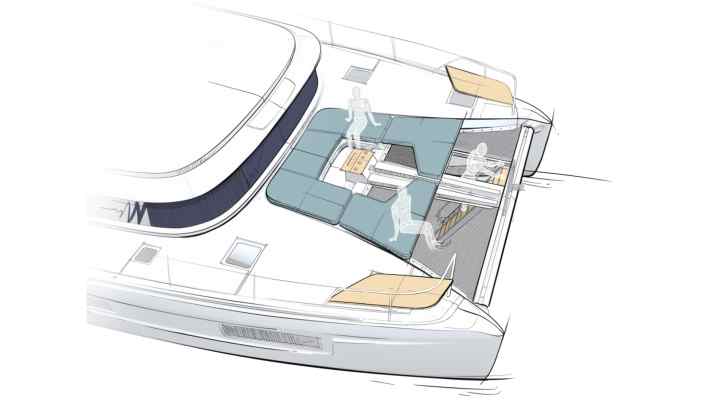
Read more from Lagoon:
The 46 comes with new, more voluminous, upwardly projecting hulls, up-to-date rig geometry, a revised deck, new sterns and many small improvements. For example: A small projection of the bathing platform, the so-called scoop, makes boarding from the side gangway easier. The cockpit is reached after two steps and the deck after a further three, where the predecessor and others offered ergonomically more difficult solutions. The fly can be reached from the cockpit on the port side or from the deck on the starboard side. The wheel is positioned in the centre. The competition tends to use wheels aft or half-height helm stations to starboard (the name says it all).
The advantages: It is easier for the helmsman to maintain contact with his fellow sailors in the guest cockpit. And all four hull ends can be seen, which is a positive feature when manoeuvring in port. In order to be able to better observe the sterns of the Lagoon 46 and estimate their distance to the pier or jetty, the shipyard also offers reversing cameras whose signals can be switched to the plotter. Unusual at first, but why not?
On the Lagoon, the helmsman sits in the centre, has short distances to both sides of the boat and can quickly and easily look into the sails on each bow. Behind him is the lounge area on a 2.25 by 2.10 metre sunbathing area. And this is where the high-rise effect really comes into its own: an unobstructed view of the sea, even in the harbour, the pier is no longer an obstacle to the view. The mast is located directly in front of the central wheel, so it is positioned quite far aft. The background to this is the desire for a self-tacking jib that is as large as possible and therefore more effective. The mainsail became quite narrow as a result, and the boom is set quite high due to the flybridge and debatable safety concerns. This may be easy on the non-thinking head, but makes it more difficult to hoist the mainsail and results in certain visual deficits.
Surprising properties under sail
In terms of sailing, however, there are definitely positive behavioural characteristics. The Lagoon 46 gets going quite well even in light winds, and in smooth water even under ten knots of true wind it is a joy to sail. The boat tacks well without backing the headsail, which would not be easy with the self-tacking jib. Weight and sails seem to be in good harmony.
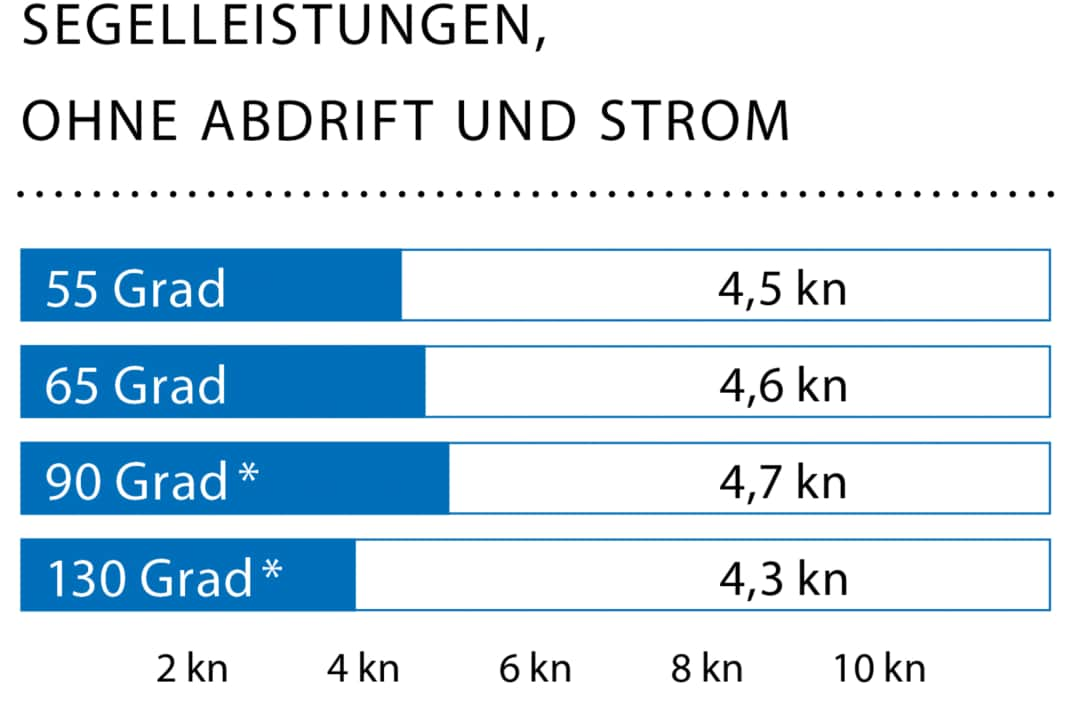



Depending on the type, the rudders provide very little feedback on the long transmission path to the wheel on the flybridge. In this context: The screws are positioned aft of the rudder fins. The lack of airflow to the blades is not a problem, as in the harbour the two engines are used for steering anyway and not the rudders. The advantage: the engines can be installed far aft in the sterns, completely thermally, acoustically and olfactorically separated from the living area, which also creates more living space.
Back on deck: Operation does not pose any problems, even for the solo skipper. The elements converge in the centre of the fly, even the Code Zero (recommended for the sail plan with self-tacking jib) can be sheeted from above. Electric winches are highly recommended as an extra, at least for the halyards.
The strongly flared, almost rectangular mainsail, sewn from Dacron as standard like the jib, weighs a lot, also because of the five continuous battens and corresponding fittings. It is also advisable to invest in higher quality cloth with a longer profile. The optional traveller, which can be operated at the touch of a button, is also a useful main trim instrument.
Few options
The central arrangement of the controls around the helm station results in a clear division: sailing and manoeuvring only takes place in the area of the helm station. This runs across the entire width of the deckhouse and thus offers more space than the half-height solution, which comes into its own when several sailors want to work on sheets, halyards and outhauls.
The permanently covered aft main cockpit with dining table and canopies, the open sunbathing lounge on the upper deck and the combination of front seating area and trampoline are ideal for sunbathing and pure relaxation. In typical catamaran style, the stern cockpit, which is open to the bathing platforms on both sides, and the saloon in the deckhouse, which is at the same height and separated only by a glass wall with sliding door and window and the galley counter, merge into one. A refrigerator outside and one inside, plus a freezer, are due to the potentially large crew and the mostly warm cruising areas.
The straight-lined, angular fittings are covered with rather dark Alpi walnut veneers. You have to like the look of this; an alternative is not yet available. However, the ship still appears light in colour: The proportion of wood is balanced, the window areas are large.
There are options with regard to the interior layout. The port hull is equipped with two cabins and two bathrooms. This is either repeated in mirror image on the starboard side, or the customer orders the more expensive owner's version. In this case, there is a sleeping area, a lounge with sofa and desk, plenty of cupboard space and a very large bathroom. In this version, the hull can be completely separated with an angled sliding door.
Regardless of the version, the following applies to every cabin: the storage space in cupboards, open shelves and drawers under the berths is sufficient for two, the lighting with reading lamps and spotlights is adequate, there are large hull windows, and the cross ventilation is better than on most monos thanks to several hinged windows. Of course, the headroom is long: at least 1.95 metres everywhere. The berths are almost 1.60 metres wide.
But there are - of course - also small downsides. The Lagoon 46 is not exclusive to the Lagoon 46, but like so many other mass-produced products, it has some unsightly joints and gaps in the fittings and cables laid in the bilge. There are also some areas in the bilge that have not been sealed with topcoat.
Major direct competition
The Lagoon 46 is in direct competition with products from the number 2 in the cat market, Fountaine Pajot (Read the test of the Fountaine Pajot Elba 45 here), the equally important South African shipyard Robertson & Caine (Video about the Leopard 45), which is strongly represented in the charter market through its partner Sunsail, Bavaria's smaller subsidiary brand Nautitech and the manufacturer Bali, a still young offshoot of the sportier Catana twin-hulls, also from France.
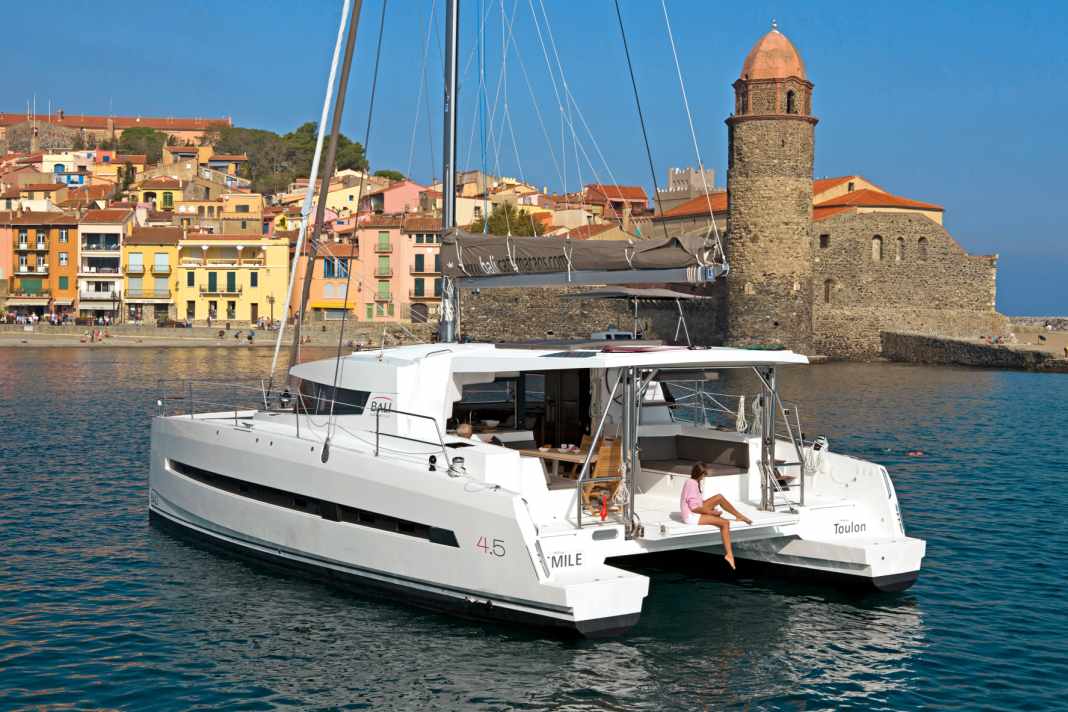




Prices of the Lagoon 46
Lagoon is almost alone with the central steering position on the flybridge, but not with the prices. They are at a very similar level. A lot of money and a difficult choice overall, which will also be significantly influenced by the delivery times, which can currently be up to one and a half years.
- Base price ex shipyard: 817,290 € gross incl. 19% VAT.
- Guarantee/against osmosis: 2/5 years
As of 02/2025, how the prices shown are defined, read here!
This will only change when the shipyards increase their capacities as planned. However, the waiting time can be easily bridged with charter cruises. And the range of catamarans available in the 45-foot class is particularly large and up-to-date.
YACHT review of the Lagoon 46
The Lagoon 46 is a typical modern cruising cat: space-optimised, comfortable, slightly better sailing than previous generations and just as suitable for the charter market as for the demands of owners
Design and concept
Sophisticated rig concept
Good all-round visibility
Solid construction
Only one type of wood available
Sailing performance and trim
Ordinary properties
Centralised and simple operation
Living and finishing quality
Good ventilation options
Unsightly gaps and joints
Partially no topcoat in the bilge
Equipment and technology
High standard of equipment
Cable in the bilge
The Lagoon 46 in detail
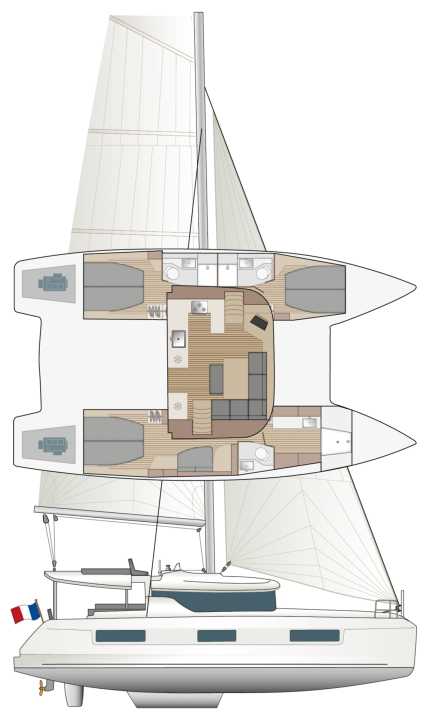
Technical data of the Lagoon 46
- Design engineer: VPLP Design
- CE design category: A
- Torso length: 13,76 m
- Width: 7,96 m
- Depth: 1,30 m
- Weight: 16,6 t
- Mainsail: 87,0 m²
- Self-tacking jib: 50,5 m²
- machine (Yanmar): 2 x 33 kW/45 hp
Hull and deck construction
Sandwich construction using the vacuum infusion process with balsa wood as the core material. Plywood bulkheads glued and laminated.

